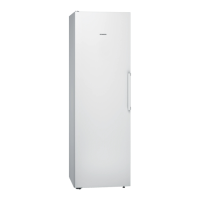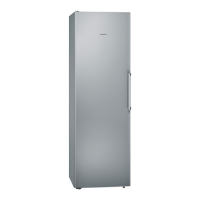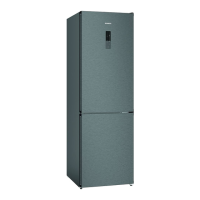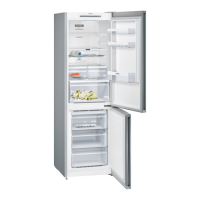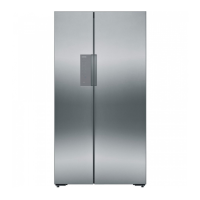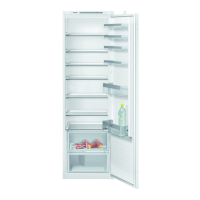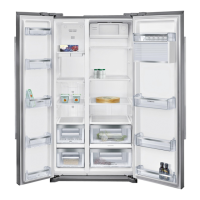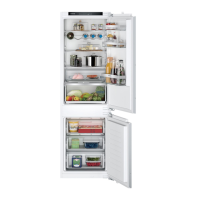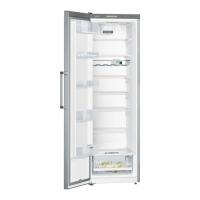
Do you have a question about the Siemens iQ300 KS36VVI3VG/02 and is the answer not in the manual?
| Category | Refrigerator |
|---|---|
| Type | Freestanding |
| Climate class | SN-T |
| Door hinge | Right |
| Door reversible | Yes |
| Number of Shelves | 7 |
| Number of Door Bins | 4 |
| Height | 1860 mm |
| Width | 600 mm |
| Depth | 650 mm |
| Defrost System | Automatic |
| Total net capacity | 346 liters |
| Noise level | 39 dB |
| Net capacity of the refrigerator compartment | 346 liters |
Read operating and installation instructions carefully for important information on installation, use, and maintenance.
Details on the flammable refrigerant (R600a), its environmental impact, and safety precautions if it escapes.
Actions to take if damage occurs: keep flames away, ventilate room, switch off appliance, inform customer service.
Do not use electrical appliances inside, avoid steam cleaners, use caution with sharp implements, store flammable substances safely.
Guidelines for ensuring children and vulnerable individuals understand hazards and are supervised during use.
Keep children away from packaging and parts to prevent suffocation risk from cartons and plastic film.
Do not allow children to play with the appliance; keep keys out of reach if a lock is present.
Details appliance suitability for refrigerating food, home use, EU directives, and safety regulations.
Instructions for environmentally friendly disposal of packaging materials and where to inquire about current disposal methods.
Guidance on recycling old appliances, compliance with WEEE directive, and professional disposal of refrigerant.
Lists all items included in the delivery, such as the appliance, interior fittings, installation materials, and manuals.
Recommends a dry, well-ventilated room, away from direct sunlight and heat sources, with minimum distances specified.
Explains climate classes, temperature ranges, and the importance of clear ventilation for efficient operation.
Recommends using customer service for changing door hinges and provides a warning about disconnecting power.
Advises waiting at least 1 hour after installation before switching on to allow compressor oil to settle.
Details socket requirements, protective conductor, fuse rating, and checks for non-European countries.
Warns against connecting the appliance to electronic energy saver plugs and discusses inverter compatibility.
Identifies and describes the function of the On/Off button, temperature display, and temperature selection button.
Instructions for switching on the appliance using the On/Off button and notes on initial cooling and recommended settings.
Explains normal condensation formation on the rear panel and actions to take if condensation forms on shelves.
Details how to set the refrigerator compartment temperature using the selection button and how the display indicates the set value.
Provides advice on storing fresh food, ready-made products, and covering food to retain aroma and freshness.
Explains chill zones and recommends storage for perishable items, cheese, and butter.
Explains how to set air humidity for produce and manage condensation for optimal climate.
Advises storing fruit and vegetables sensitive to cold outside the refrigerator at specific temperatures.
Explains the super cooling function, its duration, automatic switch-off, and when to use it for rapid cooling.
Instructions on how to adjust or remove glass shelves by pulling them out and lifting the front.
Explains how to adjust the height of the door shelf downwards or upwards using side buttons or by lifting.
Instructions on how to remove a door shelf by lifting it upwards.
Describes how bottles can be stored securely on the bottle shelf and how the holder can be adjusted.
Notes that the breakfast set containers can be removed and filled individually.
Explains the 'OK' sticker's purpose in checking refrigerator compartment temperature and when to adjust settings.
Instructions for turning off the appliance using the On/Off button, resulting in the temperature display going out.
Steps for disconnecting the appliance for prolonged periods: switch off, unplug, clean, and leave door open.
Warnings against abrasive agents, solvents, scouring sponges, and cleaning shelves/containers in the dishwasher.
Step-by-step guide for cleaning, including switching off, unplugging, removing food, thawing frost, and wiping surfaces.
Instructions for regularly cleaning the condensation channel and drainage hole using a cotton bud.
States the appliance has a maintenance-free LED light and that repairs should only be done by customer service.
Advice on installing the appliance in a dry, well-ventilated room away from heat sources and sunlight.
Tips include cooling food before storing, brief door openings, and cleaning the rear panel.
Explains fitting wall spacers for optimal energy rating and the 75mm gap limit.
Describes common noises like droning, bubbling, and clicking as normal operation of motors and refrigerant flow.
Provides solutions for noises caused by an unlevel appliance, it not being free-standing, or items touching each other.
A table listing common faults, their possible causes, and remedial actions for self-resolution.
Details how to initiate an automatic self-test program to identify faults that may require customer service.
Provides guidance on finding local customer service and the necessary information (E-Nr., FD-Nr.) to quote.
Lists contact numbers for customer service in different regions (GB, IE, US) for repair orders and advice on faults.
